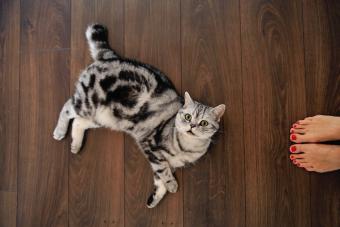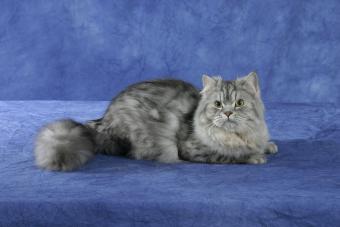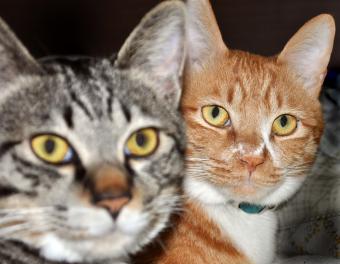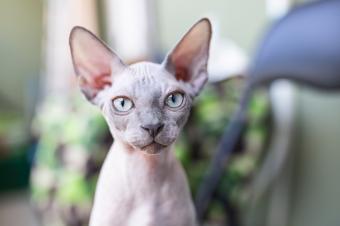
You may think you know everything there is to know about tabby cats. But can you tell the difference between a grey and silver coat tabby? Or whether your cat is a marbled tabby or a classic tabby? (trick question: they're the same!) Learn what makes a tabby a tabby and why this is one of the most beloved cat types out there.
Tabby Cat Patterns
Strictly speaking, tabby cats aren't actually a single cat breed. Tabby is actually a coat pattern, and it's thought that if cats were allowed to breed indiscriminately, more than half of the cat population would be tabby. That said, there are several types of tabby coat patterns:
- Mackerel
- Classic
- Spotted
- Ticked
- Lynx point
- Patched
Most tabby cats have a distinctive face marking on their foreheads that looks like a capital "M."
Mackerel Tabby Pattern

The most common pattern for a tabby cat looks like the stripes on a tiger. The correct term is a "mackerel tabby," although this pattern is also called tiger tabby or striped tabby. This correct terminology isn't obvious until you consider that the stripes resemble the bones of a fish. That's a good way to remember it. Mackerel fish have stripes, and so do mackerel tabby cats.
Tabbies are often "dressed up" with white paws and even a white bib.
Classic Tabby Pattern

Another tabby pattern is the blotched or marbled tabby, also confusingly called the "classic tabby." This pattern is characterized by swirls, and the rings around the legs and tail are often much wider than the rings of the mackerel tabby. Classic tabby patterns are often compared to a bullseye on target. The American Shorthair often has the classic tabby pattern.
Spotted Tabby Pattern

A spotted tabby has spots instead of stripes. Sometimes the spots look like a series of small circular dots. Other spotted tabbies will have rosettes. This pattern is most common in the bengal, Egyptian mau, and Maine coon breeds, but they can be found in others.
Ticked Tabby Pattern

A less obvious tabby is the stripeless pattern found on cats like the Abyssinian and Somali. Their fur is ticked like a squirrel's and while this is considered a tabby pattern, many consider it a bit of a stretch to include as a tabby type. Ticked fur is also known as an agouti tabby, which refers to the agouti gene that produces hair with more than one color on each strand.
These cats may also have striping on their legs or tail, and often a dark stripe running along their back above their spine.
Lynx Points

One of the most interesting variations is seen in cats with Siamese coloring and tabby points. These cats have the fawn-colored body and face, with legs and tail showing faint or distinct tabby markings in the point coloration. This is known as a lynx point pattern. You'll notice these cats look like wild cats, hence the term lynx being involved in their color pattern.
This pattern is found in Siamese, Balinese, colorpoint shorthair, Birman, Himalayan, and ragdoll cats.
Patched Tabby

Sometimes you'll see cats that have more than one pattern on their bodies, such as a mix of splashes and patches of tortoiseshell and calico coloring next to areas of tabby colors and patterns. These cats are affectionately known as "torbies" if they have tabby and tortoiseshell colors and "tabicos" or "calibies" for a mix of tabby and calico patterns. Some other patched tabbies are blue, brown, or silver tabbies with patches of red or cream on their fur.
These cats are often female because the gene for orange shading is linked to the X chromosome, and female cats have two X chromosomes.
Tabby Cat Colors
Tabbies can come in several colors, including a varicolored pattern. In addition to the varicolored coat color, you could see these tabby cat colors:
- Red
- Grey
- Silver
- Cream
- Blue
- Brown
Red Tabby

Red tabbies can come in many shades that range from a pale yellowish shade to a vibrant orange or a deep rust color. These cats are also called ginger or orange tabbies.
Grey Tabby

Grey tabbies have light to medium grey fur with stripes that can be a dark grey to black color. Their coat has more contrast and parts are darker than in silver tabbies.
Silver Tabby

Silver tabbies are similar to grey tabbies, but their fur has a shimmery silver sheen to it. The hair is grey with white roots. These cats are also known as silver agouti cats. Their stripes are dark grey to black.
Cream Tabby

Cream tabbies have fur that looks like a soft beige or tan color with stripes. The stripes are a darker shade of the same color, and can appear like sand or peach. These tabbies may be harder to discern as tabbies until you're up close. Their stripes and background color are both lighter, but they're usually distinct once you're close enough.
Blue Tabby

Blue tabby cats have cream, buff-colored, or light grey/bluish fur with stripes that are either dark grey or a blue-grey color.
Brown Tabby

Brown tabbies tend to have lighter colored fur that is shaded medium brown or bronze, with stripes and/or spots that are a dark brown to black color.
Varicolor Tabbies

Some tabby cats are varicolored. That is, they have some tabby patches on a mostly white coat, or orange and brown tabby patches mixed on a white coat. Oddly, these variations only occur on an otherwise white-coated cat. You simply don't see tabby patches on a black cat. No one knows why this should be.
Torbies and Tabicos
Sometimes you'll see cats that have more than one pattern on their bodies, such as a mix of splashes and patches of tortoiseshell and calico coloring next to areas of tabby colors and patterns. These cats are affectionately known as "torbies" if they have tabby and tortoiseshell colors, and "tabicos" for a mix of tabby and calico patterns.
Tabby Faces
Tabby cats have unusual and attractive facial markings, similar to a tiger's. Most tabbies have some features in common on their faces.
The Tabby "M"

Most tabbies have what looks like a letter "M" on their foreheads between their ears, and a number of legends have arisen to account for this. The "M" was supposedly bestowed on a favored or brave cat by either the Virgin Mary or the prophet Mohammed.
Tabby Eyeliner

Tabby eyes have the long stripe of "eyeliner" on the cheek, similar to the Egyptian symbol, the "Eye of Horus" (also known as the Eye of Ra). It is possible that the sign was adopted from cats, because they were revered in ancient Egypt and often mummified and buried with their owner. Many tabby cats also have pale areas of fur right around the "eyeliner," which makes it stand out more.
Other Tabby Features
In addition to their forehead and eyes, tabbies have some other patterns in common:
- Tabbies often have thin pencil line patterns on their faces. These may be harder to see depending on the cat's base coloring.
- Tabbies usually have stripes and bars on their legs that are horizontal, along with "bracelets" around their paws.
- A dark stripe that runs from about their shoulders to the base of their tail along the spine is common.
- Some classic tabbies have a pattern on their shoulders that is described as a "butterfly."
Tabby Cats Are Here to Stay
Whatever their origin, tabby cats are exceedingly popular, and it's doubtful the world will ever see their decline. This is especially true since all cats have the gene for the tabby pattern in their genetic makeup.







